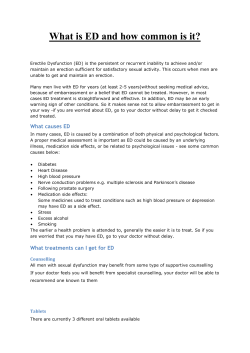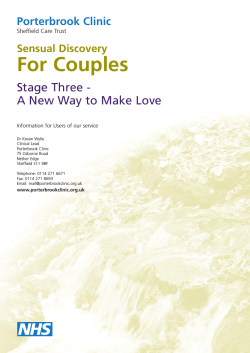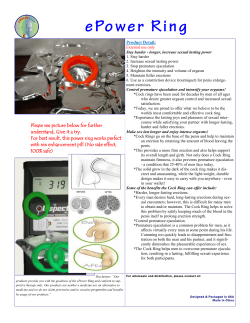
Erectile Dysfunction Causes & Treatments for Active Seniors
Erectile Dysfunction Causes & Treatments for Active Seniors Erectile dysfunction (ED) is the inability to maintain an erection long enough for sexual intercourse. This is different from impotence in that it only concerns the ability to have an erection whereas impotence addresses issues surrounding sexual desire, ejaculation, and orgasm. ED can describe inconsistent patterns of erection or the inability to attain one at all, but all are presumed to interfere with sexual activity. There has been a dramatic increase in reported cases of ED from about 8 in 1000 in 1985 to 22 in 1000 in 1999. This has been attributed to higher media coverage of the disorder due to the highly publicized drug, Viagra, which made its debut in 1998. Senior citizens are more prone to ED due to the effects of aging which subsequently can result in chronic illness, overall decrease in physical functioning, and increased use of medication. Any condition that compromises nerve function or blood flow has the potential of causing symptoms like ED. Although it is more common in senior citizens, men of all ages can experience ED, but many have also experienced successful improvement from treatments like Viagra. How Does an Erection Occur? Two chambers run the length of the penis; they are jointly called the corpora cavernosa. These chambers are filled with a spongy tissue comprised of smooth muscle, fibrous tissues, spaces, veins, and arteries, all engulfed by a membrane called the tunica albuginea. The channel that contains urine and ejaculate, or the urethra, runs beneath the corpora cavernosa. Mental or sensory stimulation causes the muscles of the two chambers to relax via nerve signals from the brain. This allows blood to flow into the penis while the membrane of the chambers traps the blood that gathers in the spaces there. An erection is the result of the penis expanding due to the trapped blood in the chambers and is only reversed when the muscles contract which stop blood flow. Erectile Dysfunction Because nerves, muscles, and other tissues are involved in the maintenance of an erection, disruption of any of these things and their associated functions can contribute to ED. The most common cause of ED in senior citizens results from damage to nerves and tissue as a result from aging and disease. Diabetes, kidney disease, alcoholism, multiple sclerosis, heart disease, and vascular disease account for a majority of ED cases. Unhealthy lifestyles that include overeating, smoking, and lack of exercise can contribute to susceptibility to ED. Nerve damage caused to the prostate, bladder, or spinal cord by surgery or injury can effect erectile functioning. Side effects of some medications include ED, and there are other less common causes that include psychological stress and hormonal abnormalities. Diagnosing ED Physicians may ask about medical history, or information about illness and injury, that could contribute to having ED. They may also ask about sexual history which may help distinguish (800) 796-CARE | info@kennedycare.com 1 CARE RESOURCES // ERECTILE DYSFUNCTION & TREATMENTS FOR SENIORS between ED and other issues like impotence. While both prescribed and illicit drugs can cause erectile dysfunction, sometimes physicians can reverse these adverse effects by either decreasing dosage or substituting certain medications. A physical exam can reveal some underlying problems contributing to ED. Nerve damage, hormonal irregularity, circulatory issues, or abnormal characteristics of the penis itself can be identified by a physician upon examination which are all potential underlying causes of ED. Laboratory testing for blood counts, urinalysis, lipid profile, liver enzymes, and testosterone level can all reveal underlying issues that contribute to ED. Healthy men have erections during sleep (nocturnal penile tumescence), so monitoring erections that occur during sleep can help medical professionals determine whether ED is caused by physical or psychological issues. For example, if an individual were to find that nocturnal erections did not occur, the causes for ED would be attributed to physical reasons. This type of diagnostic tool is not the most reliable, however. Lastly, underlying psychological reasons for ED may be revealed by examination performed by mental health experts who often use questionnaire and interview styles of examination. ED Treatment for the Elderly Successful treatment of ED depends to a great extent on the underlying causes of the problem. While some elder men may find a change to a healthier lifestyle may solve the problem, others may have to change the types and amounts of medications they take or employ psychotherapy. Other treatments involve methods that physically induce erection or surgery that can improve the functioning of blood flow in the penis. Psychotherapy: Most psychological treatment of underlying causes of ED focus on the reduction of anxiety induced from sexual experiences which can lead to dysfunction. Therapy can involve the man diagnosed, a sexual partner, and a mental health professional. Drug Therapy: Phosphodiesterase (PDE) inhibitors, better known as Viagra, Levitra, and Cialis, are oral drugs taken before sexual activity that help relax muscles in the penis that allow blood flow to induce an erection. Doses of all of these drugs may vary depending on the patient’s current regimen of medication or sensitivity to the drug. Elder men who take medication for ED should not take these types of inhibitors more than once a day, and they should not take it at all in conjunction with other medications like nitrate-based medicine for heart disease or alpha blockers. This combination can cause a sudden drop in blood pressure. Men who suffer from ED also employ hormone therapy by taking oral testosterone or other psychotropic medications, but the effectiveness is not completely validated leading some professionals to speculate any effectiveness from these remedies are due to a placebo effect. Some men inject drugs directly into the penis which work by widening blood vessels, but they can also lead to persistent erection (priapism) and scarring. Some men rub nitroglycerin directly on the penis, which can sometimes enhance erection. (800) 796-CARE | info@kennedycare.com 2 CARE RESOURCES // ERECTILE DYSFUNCTION & TREATMENTS FOR SENIORS There is another method which involves inserting a pellet into the penis which induces an erection within 10 minutes. This can cause aching in the penis, testicles, and area between the penis and rectum. It can also cause a burning sensation in the urethra where it is inserted, redness, bleeding, and spotting. Non-Drug Treatments for Erectile Dysfunction (ED) Other methods include vacuum devices which involve attaching an airtight tube to the penis in order to draw out air and engorge the penis with blood. Often, a plastic band placed around the base of the penis is also used after removing the vacuum in order to maintain the erection. Some may opt for surgeries that implant devices that aid in erection, artery reconstruction, or blocking veins that allow blood to flow out of the penis. Surgery to repair arteries is not recommended for older men with widespread blockage, and the long term effectiveness of intentional vein blockage is not completely validated. Devices inserted into the penis surgically usually involve a pair of rods that function within the corpora cavernosa which can be adjusted manually. Other rods are inflatable and expand by using pressurized fluid whose release can be triggered manually. This has the advantage of leaving the penis in a more natural state when not inflated. Infection and mechanical malfunction are risks associated with any prosthesis implanted within the penis. It may be helpful for senior citizens to share their condition and treatment plan with both their partners and health professionals involved in their eldercare. Some stigma may be associated with ED making it difficult to share. Still, it is important to avoid complications that may arise by not maintaining open communication, especially with professionals providing elder care. (800) 796-CARE | info@kennedycare.com 3
© Copyright 2025





















